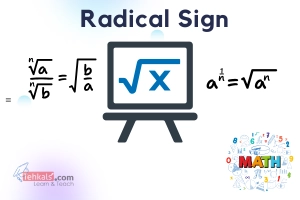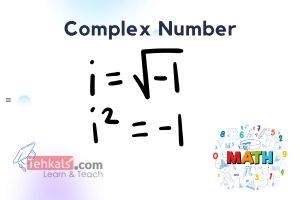Exponent Rules
Published: 12 Aug 2023
In mathematics, exponent rules are the fundamental concept that holds great significance across various fields, from basic arithmetic to complex scientific equations. Exponents, also known as powers, allow us to express repeated multiplication. Exponent rules are difficult to understand, so these rules are explained and simplified in this article.
What are Exponents?
Exponents are shorthand notations used to represent the repeated multiplication of a base number by itself.
In the expression $ a^n $, $ \ a $ is the base, and $ n $ is the exponent, power or index. The value of $ a $ is multiplied by itself $ \ n $ times. For example, $ a^3=a . a . a $
Explanation:
Let us have $ 4^3 $, where the base is $ 4 $, and the exponent is $ 3 $, which means that $ 4 $ is multiplied by itself three times: $ 4 \times 4 \times 4= 64 $.
The Exponent Rules
Understanding the exponent rules are difficult for simplifying and manipulating expressions involving powers. Here are the key exponent rules:
Product Exponent Rules
To multiply the powers of the same base, keep the same base and add the exponents.
- $ a^m \times a^n = a^{(m + n)} $
Example:
$ 2^2 \times 2^3 = 2^{(2 + 3)} = 2^5 = 32 $
Quotient Exponent Rules
When the same bases are divided with different exponents, keep the same base and subtract their exponents. Symbolically:
- $ \frac {a^m}{a^n} = a^{(m – n)} $
Example:
$ \frac {10^4} {10^2} = 10^{(4 – 2)} = 10^2 = 100 $
Power Exponent Rules
When a number is raised to an exponent and then raised to another exponent, keep the base same and multiply the exponents together. In mathematical terms:
- $ \left(a^m\right)^n= a^{m * n} $.
Example:
$ \left(2^3\right)^2= 2^6 = 64 $
Zero Exponent Rules
If there is zero power on any non-zero number is equal to 1. Essentially:
- $ a^0 = 1 $, where $ a $ is any non-zero real number.
Negative Exponent Rules
When a number with a negative exponent is moved to the denominator of a fraction, the exponent’s sign becomes positive. Formally:
- $ a^{-n} = \frac {1} {a^n} $
Example:
$ 5^{-2} = \frac{1} {5^2} = \frac{1}{25} $
Negative Base Rule
Odd Exponent
When a negative number is raised to an odd exponent, the result is negative.
Example:
$ (-2 )^3 = -8 $.
Even Exponent
When a negative number is raised to an even exponent, the result is positive.
Example:
$ (-2 )^2 = 4 $
Exponent Rules – MCQs
1. $ a^m \cdot a^n= $O $ a^{\frac{m}{n}} $
O $ a^{m-n} $
O $ a^{\frac{n}{m}} $
O $ a^{m+n} $
Show Answer
$ a^{m+n} $
Explanation:
To multiply powers of the same base, keep the base same and add the exponents.
2. $ \frac{a^m}{a^n}= $
O $ a^{\frac{m}{n}} $
O $ a^{m-n} $
O $ a^{\frac{n}{m}} $
O $ a^{m+n} $
Show Answer
$ a^{m-n} $
Explanation:
To divide two expressions with the same bases and different exponents, keep the base same and subtract the exponents.
3. $ \left(a^m\right)^n= $
O $ a^{\frac{m}{n}} $
O $ a^{m-n} $
O $ a^{m n} $
O $ a^{m+n} $
Show Answer
$ a^{m n} $
Explanation:
To raise an exponential expression to a power, keep the base same and multiply the exponents.
4. $ (a b)^n= $
O $ a b^n $
O $ a^n b $
O $ a b $
O $ a^n b^n $
Show Answer
$ a^n b^n $
Explanation:
To multiply different bases with same exponent, keep the exponent same and multiply the expressions with the same exponent.
5. $ \left(\frac{a}{b}\right)^n= $
O $ \frac{a^n}{b^n} $
O $ \frac{a^n}{b} $
O $ \frac{a}{b^n} $
O All of these
Show Answer
$ \frac{a^n}{b^n} $
Explanation:
To divide the two expressions with the same exponent, keep the exponent same and divide the expressions.
6. $ a^0= $
O $ a $
O 1
O 0
O None of theses
Show Answer
0
Explanation:
Any non-zero number raised to the zero power equals one.
7. $ 400^{\circ}= $
O 400
O 1
O 0
O None of these
Show Answer
1
Explanation:
Any non-zero number raised to the zero power equals one.
8. $ a^{-n}= $
O $ \frac{1}{a^n} $
O $ \frac{1}{a^{-n}} $
O $ a^n $
O None of these
Show Answer
$ \frac{1}{a^n} $
Explanation:
If we convert the Numerator having a Negative exponent, moves it to Denominator and the exponent becomes positive.
9. $ \frac{1}{a^{-n}}= $
O $ \frac{1}{a^n} $
O $ \frac{1}{a^{-n}} $
O $ a^n $
O None of these
Show Answer
$ a^n $
Explanation:
If we convert the Denominator having a Negative exponent, moves it to Numerator and the exponent becomes positive.
10. $ (-a)^3 \times(-a)^4= $
O $ a $
O $ a^7 $
O $ a^4 $
O $ -a^7 $
Show Answer
$ -a^7 $
Explanation:
$ (-a)^3 \times(-a)^4=(-a)^{3+4} $
$ (-a)^3 \times(-a)^4=(-a)^7 $
$ (-a)^3 \times(-a)^4=-a^7 $
11. $ \left(-2 a^2 b^3\right)^3= $
O $ 8 a^6 b^9 $
O $ 2 a^2 b^3 $
O $ 2 a b $
O $ -8 a^6 b^9 $
Show Answer
$ -8 a^6 b^9 $
Explanation:
$ \left(-2 a^2 b^3\right)^3=\left(-2 \right)^3 a^{2 \times 3} b^{3 \times 3} $
$ \left(-2 a^2 b^3\right)^3=-8 a^6 b^9 $
12. $ \frac{a^0 \cdot b^0}{2}= $
O 1
O 2
O $ \frac{1}{2} $
O 0
Show Answer
$ \frac{1}{2} $
Explanation:
$ \frac{a^0 \cdot b^0}{2}=\frac{1 \times 1}{2} $
$ \frac{a^0 \cdot b^0}{2}=\frac{1}{2} $
13. $ \left(\frac{a^2}{b^4}\right)^{\frac{3}{2}}= $
O $ \frac{a^2}{b^4} $
O $ \frac{a}{b} $
O $ \frac{a^3}{b^6} $
O None of these
Show Answer
$ \frac{a^3}{b^6} $
Explanation:
$ \left(\frac{a^2}{b^4}\right)^{\frac{3}{2}}=\frac{a^{2 \times \frac{3}{2}}}{b^{4 \times \frac{3}{2}}} $
$ \left(\frac{a^2}{b^4}\right)^{\frac{3}{2}}=\frac{a^{1 \times 3}}{b^{2 \times 3}} $
$ \left(\frac{a^2}{b^4}\right)^{\frac{3}{2}}=\frac{a^3}{b^6} $
14. $ (\sqrt[3]{a})^{\frac{1}{2}}= $
O $ a^{\frac{1}{6}} $
O $ a^{\frac{1}{3}} $
O $ a^{\frac{3}{2}} $
O $ a^{\frac{2}{3}} $
Show Answer
$ a^{\frac{1}{6}} $
Explanation:
See Ex # 2.4 Q No. 3 Part (iv)
15. $ \sqrt[8]{x^8} \cdot \sqrt[8]{x^8}= $
O $ \sqrt[8]{x^8} $
O $ x^8 $
O $ x $
O $ x^2 $
Show Answer
$ x^2 $
Explanation:
$ \sqrt[8]{x^8} \cdot \sqrt[8]{x^8}=\left(x^8 \right)^{\frac{1}{8}} \left(x^8 \right)^{\frac{1}{8}} $
$ \sqrt[8]{x^8} \cdot \sqrt[8]{x^8}=x \cdot x $
$ \sqrt[8]{x^8} \cdot \sqrt[8]{x^8}=x^2 $
- Be Respectful
- Stay Relevant
- Stay Positive
- True Feedback
- Encourage Discussion
- Avoid Spamming
- No Fake News
- Don't Copy-Paste
- No Personal Attacks
- Be Respectful
- Stay Relevant
- Stay Positive
- True Feedback
- Encourage Discussion
- Avoid Spamming
- No Fake News
- Don't Copy-Paste
- No Personal Attacks


